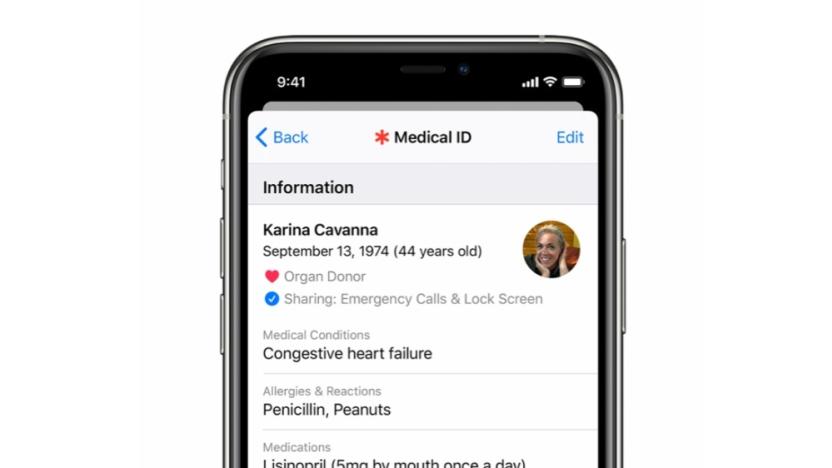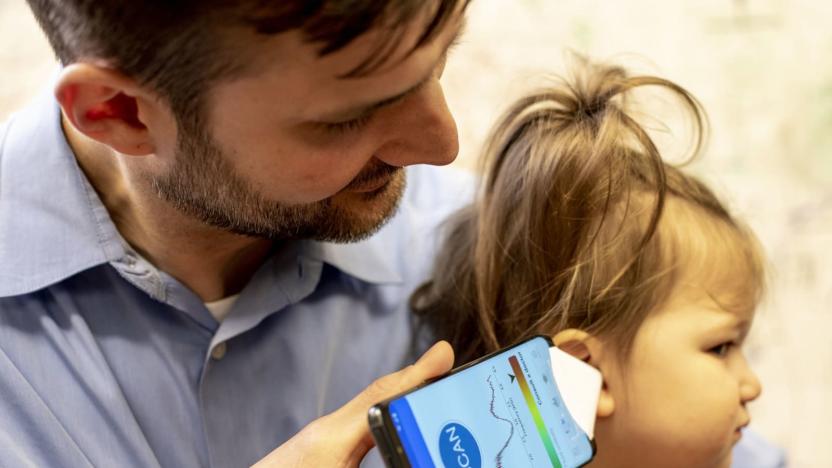Health App
Latest

iOS 13.5 can automatically share your Medical ID in an emergency call
The next release of iOS 13 will include a feature that will allow you to automatically share your Medical ID with 911 call center operators.

Samsung finally adds period tracking to its Health app
The Samsung Health app is finally offering a long-awaited feature: period tracking. According to SamMobile, Samsung is rolling out an update, version 6.9.0.055, which adds a new women's health category and allows users to track their menstrual cycles.

Parents may be able to spot ear infections with a paper cone and an app
Researchers are working on a smartphone app that could help diagnose ear infections. As NPR reports, the app uses the phone's microphone, its speaker and a small paper cone. In its current form, the app sends short, sound pulses through a funnel and into the ear canal. It then measures the echo of that sound, and an algorithm uses the reading to predict if there's fluid behind the eardrum, one of the common symptoms of infection.

The iOS 8 Health app: What can you do with it today?
Note: At the time of this post Apple has acknowledged issues with HealthKit have delayed numerous third-party health apps. One of the big announcements out of WWDC 2014 was the iOS 8 Health app and the entire HealthKit framework. The framework is designed to allow third-party app and hardware vendors feed activity and health data into the Health app, which can then -- at some undetermined future time -- be used to communicate that information to your health care providers. Well, iOS 8 is available and the Health app is too, but there's not a lot you can actually do with it right now. Let's take a quick look at the app and how you can use it today. Health has four buttons at the bottom of the screen that demarcate the functionality of the app. First is Dashboard, which will be the repository for information on weight, activity, standing time, stairs climbed, and whatever else can be tracked by your fitness monitor or Apple Watch. The Dashboard is going to be awfully lonely until third parties actually get to add data to the Health Data repository, the second button on the app. One look at Health Data shows you all of the areas that are currently under consideration for storage on your iPhone -- body measurements (fat percentage, BMI, height, lean body mass, weight), fitness (active calories, cycling distance, flights climbed, NikeFuel, resting calories, steps, walking + running distance), "me" (birthdate, biological sex, and blood type), nutrition (biotin, caffeine, calcium, carbohydrates, chloride, chromium, copper, dietary calories, dietary cholesterol, fiber, folate... this list goes on forever), lab results (everything from Blood Alchohol Content to Peripheral Perfusion Index), sleep (interesting, since it's unknown if the Apple Watch is usable as a sleep monitor), and the ever-popular vital signs (blood pressure, body temperature, heart rate, and respiratory rate). Once you've entered data into any one of those hundreds of categories, you can view the numbers for the day, week, month or year. The third button is Sources, which identifies those apps or devices with associated apps that have actually requested permission to update your data. Finally, the one item that you can actually use right now is Medical ID. This can be a very useful tool for loved ones or emergency responders to use in case of a sudden illness or accident, as they do not need to know your device passcode or use your bloody fingertip on a Touch ID Home button to see the information. Instead, they can punch the Home button, swipe to the right to bring up the passcode screen, then tap Emergency. This function used to do one thing -- let others use your phone to call 911 in an emergency situation. Now there's a tiny red "Medical ID" link in the corner that can be tapped. I entered information into this that I feel comfortable having strangers look at in case of an emergency. This includes my blood type, whether or not I'm an organ donor, my weight, my height, existing medical conditions, allergies and reactions, medications I'm on, and emergency contact information. If you don't want that information to show up when your device is locked -- in other words, you don't want to give first responders a hand in saving your life -- you can tap a Show When Locked button to turn it off of the default. As someone who does a lot of traveling, I am personally looking forward to being able to carry more health data along with me wherever I may go. The Health app is here, let's just hope that developers start taking advantage of it.

The Apple Watch health app is an incredible tool for all levels of fitness
Apple has been pushing an increased emphasis on health since this year's WWDC event, but the Health app for its Apple Watch is officially their biggest move yet. The app's goal is to motivate people to be more healthy and active, regardless of what level of fitness you're currently at. Accordingly the app is designed both for users who just want to track what they're doing during the day or who are using it to build the best body they can. To meet this goal they app has two modes, Fitness and Workout. Fitness monitors your day to day health and activity on three fronts using three "rings." You can track your progress based on how close to becoming a full circle each ring is. The Move ring measures how many calories you burn during your normal day to day activities. The Exercise ring tracks just your brisk activity, from a brisk walk or above. The ring will close out when you meet your recommend 30 minutes of activity a day. Finally the Stand ring shows how often you take a break from sitting. The ring will close when you reach a full minute of standing for each hour of the day. Workout mode is designed to work as an all-in-one fitness app/sports watch in one. It includes an accelerometer to measure body movement, tracks your heart rate, and utilizes your GPS to track distance. Not just quantity of movement, but the quality. You can select workouts from a list of popular activities, then set goals for that activity -- when you want to work out, calories, or distance. See at a glance how long, how far, and how hard you've been working out. When you're done, it will give you a summery of your session. There are even rewards or achievements for meeting goals. The app stores all your data on your iPhone allowing you to track goals and see your progress. Your data can also be shared with the Health app where it can be used with third party health and fitness apps. Over time the watch gets to know you, and delivers intelligent reminders and offers goals based on your progress. In theory, this means that if it knows you're willing to run one mile a week, it will eventually start upping your goals to encourage you to work harder. This Fitness app is truly exciting. We can't wait to get our hands on an Apple Watch to test it out.



